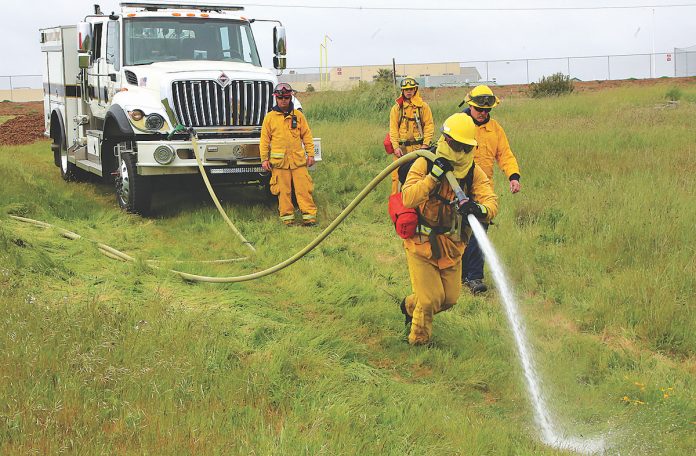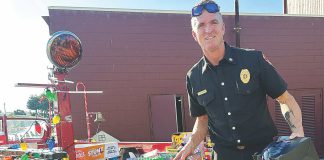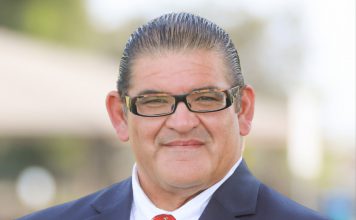SANTA CRUZ COUNTY—If Sunday’s Basin Fire is any indication of what 2021’s fire season will bring, San Mateo-Santa Cruz Unit Chief Ian Larkin and the mountains surrounding Santa Cruz County are in for a bumpy ride this fire season.
The roughly 7-acre blaze among the Big Basin Redwoods was a “sleeper fire,” Larkin said, stemming from last summer’s CZU August Lightning Complex, which damaged or destroyed nearly 1,000 structures in Santa Cruz County and charred more than 86,000 acres.
“Some roots had continued to burn through the winter, and the fire surfaced, allowing the embers to be picked up by the wind,” Larkin said. “In that area, there are a lot of dead tan oaks. They had dropped all of their leaf litter, and that created a fuel bed for the embers to catch.”
Larkin said there is still a great deal of fuel in the forest, and with the combination of high winds and lack of humidity, more fuel is being generated.
“This fire season is looking like it could be very active,” he said. “We’ve received about 50% of our average annual rainfall, and that’s very concerning, especially since we had a very dry year last year, and a fairly dry year before that. Coming into this fire season, our fuels are already in a drought-stricken state, and are starting to dry out faster than they normally would.”
That has left Larkin and his Cal Fire team looking for innovative ways to manage the fire season. The department is now using a manned aircraft equipped with an infrared camera to find hot spots in “search and destroy” missions. The hope is to handle those small blazes before they develop into sleeper fires similar to the Basin Fire.
“Some of them may be pretty remote; we’ll look to see if we can drop water on it, or if we need to get a crew in there via helicopter to get it out,” Larkin said. “By using the data generated during the flight, we’re going to do everything we can in advance of fire season to get ahead of it. We’ll be able to address issues in the burn scar before they pop up.”
If the Santa Cruz Mountains had received its typical 50-80 inches of rain, all of those hot spots would have been fully extinguished by the moisture seeping into the ground, Larkin said. But changing rainfall patterns and shortened windows in which the agency can conduct controlled burns has forced Cal Fire to instead undergo more labor-intensive, boots-on-the-ground fuel reductions.
In Big Basin, Larkin said, Cal Fire has tried to undergo controlled burns at the end of the fire season, “where we can rely on rainfall to assist with suppression, but we haven’t been able to do that for years.”
“The last controlled burn we attempted in Big Basin (in 2013), we had to manage that fire for seven days,” he said. “Forecasters had predicted rain, but it materialized many days later. Since then, we’ve relied more heavily on people-power to manage fuel reduction in the forest.”
In South County, Watsonville Fire Chief Rudy Lopez said that even though Watsonville has very little wildland acreage and wildland fires—save for a few in area sloughs and rivers—WFD trains to be of assistance to outlying agencies.
“We are a part of the solution,” Lopez said. “We are a small county but we have to support each other, whether that means on a local or state level.”
Lopez said that in a typical year WFD will support an out-of-county strike team two or three times. But last year he said WFD had eight out of area deployments.
“We are still in a drought,” he said. ‘Whether you agree or disagree, there is a sense of climate change that is impacting the state of California, and elsewhere. Now it’s automatic that we’re being deployed out of our area in far greater numbers.”
Last year was the worst fire season in the state’s history. At least 585 fires broke out across California from the same lightning storm that sparked the CZU Complex, including the SCU Lightning Complex that engulfed nearly 400,000 acres in neighboring Santa Clara County and nearby Alameda, Contra Costa, San Joaquin, Merced and Stanislaus counties.
Larkin said he is happy that the Basin Fire was brought under control so quickly, but that he’s less than optimistic about what this year could bring across a drought-stricken state.
His advice to mountain residents for this fire season?
“Hopefully they’ve been increasing their defensible space, and doing what they can to safeguard their property,” he said. “Optimally, a fire engine would be able to get to the home, and protect it with minimal effort. The ultimate goal is to do perimeter control simultaneously with structure protection.”
Cal Fire has been holding a series of webinars on Community TV for residents: May 10 will feature management of defensible space, with a follow-up webinar on May 13 concentrating on home-hardening (preparing your home for fire). For information, visit santacruzcountyfire.com/.










